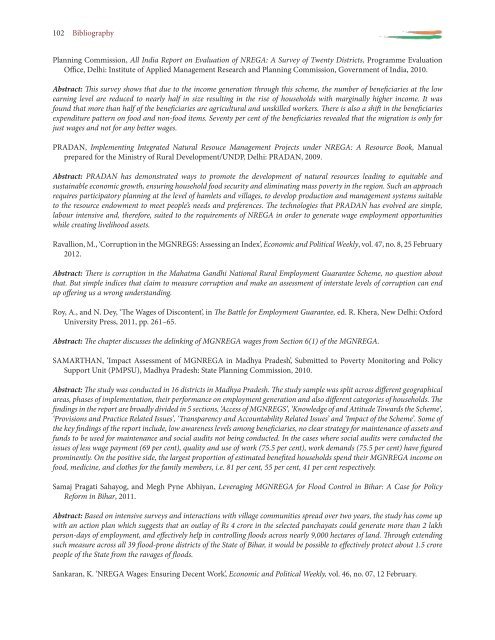MGNREGA_SAMEEKSHA
MGNREGA_SAMEEKSHA
MGNREGA_SAMEEKSHA
You also want an ePaper? Increase the reach of your titles
YUMPU automatically turns print PDFs into web optimized ePapers that Google loves.
102 Bibliography<br />
Planning Commission, All India Report on Evaluation of NREGA: A Survey of Twenty Districts, Programme Evaluation<br />
Office, Delhi: Institute of Applied Management Research and Planning Commission, Government of India, 2010.<br />
Abstract: This survey shows that due to the income generation through this scheme, the number of beneficiaries at the low<br />
earning level are reduced to nearly half in size resulting in the rise of households with marginally higher income. It was<br />
found that more than half of the beneficiaries are agricultural and unskilled workers. There is also a shift in the beneficiaries<br />
expenditure pattern on food and non-food items. Seventy per cent of the beneficiaries revealed that the migration is only for<br />
just wages and not for any better wages.<br />
PRADAN, Implementing Integrated Natural Resouce Management Projects under NREGA: A Resource Book, Manual<br />
prepared for the Ministry of Rural Development/UNDP, Delhi: PRADAN, 2009.<br />
Abstract: PRADAN has demonstrated ways to promote the development of natural resources leading to equitable and<br />
sustainable economic growth, ensuring household food security and eliminating mass poverty in the region. Such an approach<br />
requires participatory planning at the level of hamlets and villages, to develop production and management systems suitable<br />
to the resource endowment to meet people’s needs and preferences. The technologies that PRADAN has evolved are simple,<br />
labour intensive and, therefore, suited to the requirements of NREGA in order to generate wage employment opportunities<br />
while creating livelihood assets.<br />
Ravallion, M., ‘Corruption in the MGNREGS: Assessing an Index’, Economic and Political Weekly, vol. 47, no. 8, 25 February<br />
2012.<br />
Abstract: There is corruption in the Mahatma Gandhi National Rural Employment Guarantee Scheme, no question about<br />
that. But simple indices that claim to measure corruption and make an assessment of interstate levels of corruption can end<br />
up offering us a wrong understanding.<br />
Roy, A., and N. Dey, ‘The Wages of Discontent’, in The Battle for Employment Guarantee, ed. R. Khera, New Delhi: Oxford<br />
University Press, 2011, pp. 261–65.<br />
Abstract: The chapter discusses the delinking of <strong>MGNREGA</strong> wages from Section 6(1) of the <strong>MGNREGA</strong>.<br />
SAMARTHAN, ‘Impact Assessment of <strong>MGNREGA</strong> in Madhya Pradesh’, Submitted to Poverty Monitoring and Policy<br />
Support Unit (PMPSU), Madhya Pradesh: State Planning Commission, 2010.<br />
Abstract: The study was conducted in 16 districts in Madhya Pradesh. The study sample was split across different geographical<br />
areas, phases of implementation, their performance on employment generation and also different categories of households. The<br />
findings in the report are broadly divided in 5 sections, ‘Access of MGNREGS’, ‘Knowledge of and Attitude Towards the Scheme’,<br />
‘Provisions and Practice Related Issues’, ‘Transparency and Accountability Related Issues’ and ‘Impact of the Scheme’. Some of<br />
the key findings of the report include, low awareness levels among beneficiaries, no clear strategy for maintenance of assets and<br />
funds to be used for maintenance and social audits not being conducted. In the cases where social audits were conducted the<br />
issues of less wage payment (69 per cent), quality and use of work (75.5 per cent), work demands (75.5 per cent) have figured<br />
prominently. On the positive side, the largest proportion of estimated benefited households spend their <strong>MGNREGA</strong> income on<br />
food, medicine, and clothes for the family members, i.e. 81 per cent, 55 per cent, 41 per cent respectively.<br />
Samaj Pragati Sahayog, and Megh Pyne Abhiyan, Leveraging <strong>MGNREGA</strong> for Flood Control in Bihar: A Case for Policy<br />
Reform in Bihar, 2011.<br />
Abstract: Based on intensive surveys and interactions with village communities spread over two years, the study has come up<br />
with an action plan which suggests that an outlay of Rs 4 crore in the selected panchayats could generate more than 2 lakh<br />
person-days of employment, and effectively help in controlling floods across nearly 9,000 hectares of land. Through extending<br />
such measure across all 39 flood-prone districts of the State of Bihar, it would be possible to effectively protect about 1.5 crore<br />
people of the State from the ravages of floods.<br />
Sankaran, K. ‘NREGA Wages: Ensuring Decent Work’, Economic and Political Weekly, vol. 46, no. 07, 12 February.


